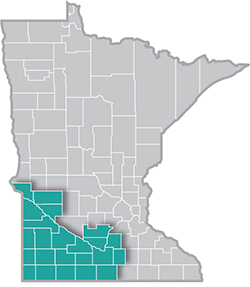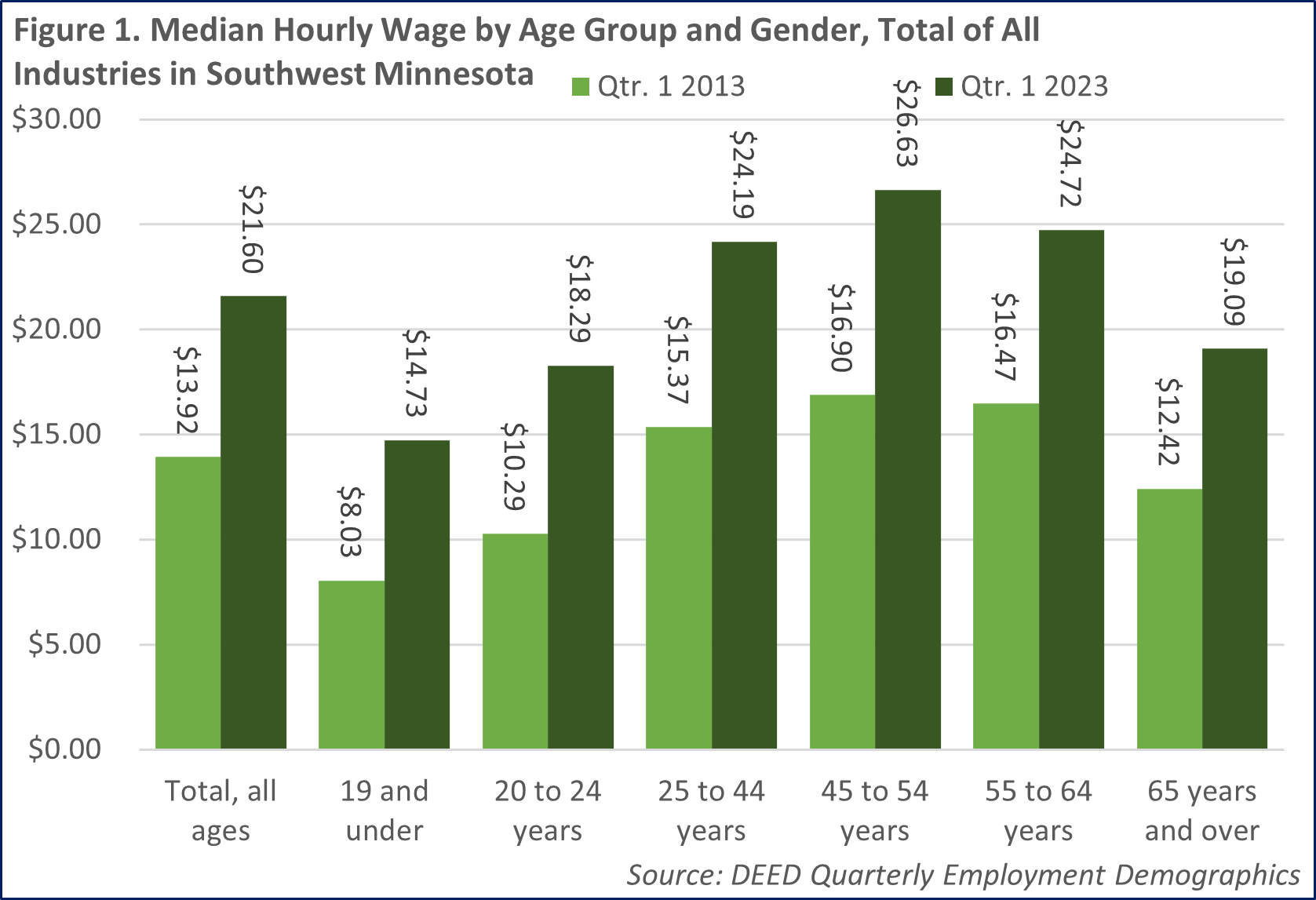 Southwest Minnesota is a national leader in agricultural production, and renewable energy.
Southwest Minnesota is a national leader in agricultural production, and renewable energy.
The region's thriving manufacturing sector includes food processing, machinery, printing, metal products, and computers and electronic products.
Want the freshest data delivered by email? Subscribe to our regional newsletters.
4/23/2024 9:00:00 AM
Luke Greiner, Amanda O'Connell
Two trends are abundantly clear when analyzing Quarterly Employment Demographics over the past two decades. Both ages and wages have been increasing for workers in Southwest Minnesota, showing a clear shift in the region's workforce. In the first quarter of 2023, almost one quarter (24.9%) of jobs in Southwest Minnesota are held by workers who are 55 years and over, up from just 15.4% 20 years ago.
Due to the size of the Baby Boom generation in Southwest Minnesota, the share of older workers has been rising over time. Back in 2003, Baby Boomers were between 39 and 57 years of age, mostly in their prime working years but starting to edge toward the traditional retirement age of 65. At that time, just 4.1% of the region's jobs were held by workers aged 65 years and over, while 63.1% of jobholders in the region were between 25 and 54 years of age.
In 2023, Baby Boomers are now between 59 and 77 years of age, replaced in the prime working years by Generation X and Millennials. Only 58.2% of the region's jobs are now held by workers between 25 and 54 years of age. Over the past two decades, the number of older workers has grown to comprise a larger share of total employment, and the median hours worked per quarter has also jumped considerably, most notably for workers in the oldest age groups (see Table 1).
| Table 1. Southwest Minnesota Workforce Demographics by Age Group, Total of All Industries, 2003-2023 | |||||||||
|---|---|---|---|---|---|---|---|---|---|
| Age | Percentage of Workers | Minnesota | Median Hours Worked | ||||||
| Qtr. 1
2003 |
Qtr. 1 2013 | Qtr. 1 2023 | Qtr. 1 2003 | Qtr. 1 2013 | Qtr. 1 2023 | Qtr. 1 2003 | Qtr. 1 2013 | Qtr. 1 2023 | |
| Total | 100.0% | 100.0% | 100.0% | 100.0% | 100.0% | 100.0% | 392 | 416 | 424 |
| 19 years & under | 9.5% | 6.8% | 6.9% | 5.4% | 5.3% | 5.4% | 105 | 104 | 109 |
| 20 to 24 years | 12.0% | 12.1% | 10.1% | 8.6% | 10.7% | 8.6% | 246 | 249 | 289 |
| 25 to 44 years | 40.9% | 38.4% | 40.8% | 44.4% | 42.9% | 44.4% | 465 | 459 | 470 |
| 45 to 54 years | 22.2% | 20.8% | 17.4% | 19.0% | 22.0% | 19.0% | 480 | 480 | 480 |
| 55 to 64 years | 11.3% | 16.9% | 17.3% | 17.0% | 15.4% | 17.0% | 442 | 472 | 480 |
| 65 years & over | 4.1% | 5.1% | 7.6% | 5.7% | 3.7% | 5.7% | 175 | 200 | 238 |
| Source: DEED Quarterly Employment Demographics | |||||||||
Though teenagers and young workers are still vital to the region's workforce, employers are clearly relying more on older workers. Median hours worked per quarter increased 8.2% across all age groups from the first quarter of 2003 to the first quarter of 2023, the equivalent of 32 additional hours, or an extra 2.5 hours per week. But for jobholders aged 65 years and over, median hours worked were up 36.0% from 2003 to 2023, equal to nearly 5 more hours worked per week.
More notably, the median hourly wage for workers in Southwest Minnesota climbed from just under $14 per hour in 2013 up to $21.60 in 2023, a rapid 55% increase over the decade. Wages were up across every age group, with the largest percentage jumps enjoyed by the youngest age groups, but the largest gains experienced in the prime working years from 25 to 54 years of age (see Figure 1).
Teenagers had the lowest starting wages, but saw an 83.4% increase from 2013 to 2023, helped in large part by rapid wage gains in the past two years as tight labor markets drew more teenagers into hard-to-fill positions in industries like Retail Trade, Accommodation & Food Services, Other Services, and Health Care & Social Assistance. Likewise, median wages climbed 77.7% for 20 to 24 year olds over the past ten years, up $8.00, thanks to job gains in the industries listed above plus Construction and Manufacturing.

The tight labor market in Southwest Minnesota is leading to new higher paying job opportunities for workers across all age groups, but particularly for older workers as the Baby Boom generation moves past the traditional retirement age, while they remains in the workforce in growing numbers. Both wages and hours worked have also been growing for older workers as the region continues to expand.
Contact Luke Greiner at luke.greiner@state.mn.us or Amanda O'Connell at amanda.oconnell@state.mn.us.